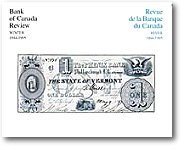Winter 1994-95
Cover: Canada: The Phenix Bank, one dollar, 1837
One of the most intriguing nineteenth century financial institutions was the phantom bank. It sprang from the severe economic depression that gripped North America from 1837 to 1839. In 1837, most U.S. banks suspended the redemption of their notes for coin for almost a year. Taking advantage of the situation, swindlers operated sham Canadian banks, issuing worthless notes that circulated mainly in the United States. Phantom bank-note frauds were usually committed by Americans against Americans.
The phantom banks had their supposed head offices in major Canadian cities. Although some were staffed, the offices were located far from the centres where the notes circulated, which made it highly unlikely that anyone would present the notes for conversion into coin.
The non-existent Phenix Bank of Phillipsburg, Lower Canada, is a classic example of a phantom bank. Using symbols resembling those of the United States, it deliberately designed its notes so that they would be mistaken for those of a Vermont-based bank. The word 'adjoining' in small letters beside Phillipsburg L.C. appears to have been a conscious attempt to avoid prosecution in Vermont. This note actually represents a double fraud, since no genuine State of Vermont notes existed. By the early 1840s, the era of the phantom bank in Canada had ended.
This one-dollar note is part of the National Currency Collection, Bank of Canada.
Photography by James Zagon.





